Focus on Wood
Quick Takes
Projects from around the globe demonstrate diverse approaches to building with wood
JARDÍN ANATOLE
In Mexico City’s Colonia Polanco neighborhood, Dellekamp Arquitectos recently completed Jardín Anatole, a four-story timber structure on a lot that had previously been the garden of a historic residential building next door. The new 10,000-square-foot structure, which houses a clothing store, a furniture showroom, and office space, is built almost entirely of oak from northern Mexico. Jardín Anatole is the country’s largest and tallest glulam building, according to the architects. Though primarily made of wood, it incorporates some concrete elements, as in its circulation core and an existing party wall provided by the neighboring building. The interiors are column-free, due to a perimeter structure that includes a second-story glulam truss and, on the levels above, closely spaced finlike elements, also of glulam. At the base, V-shaped steel perimeter columns allow the glass-enclosed “wood box” to float visually above the surrounding terraced outdoor space. Joann Gonchar, FAIA
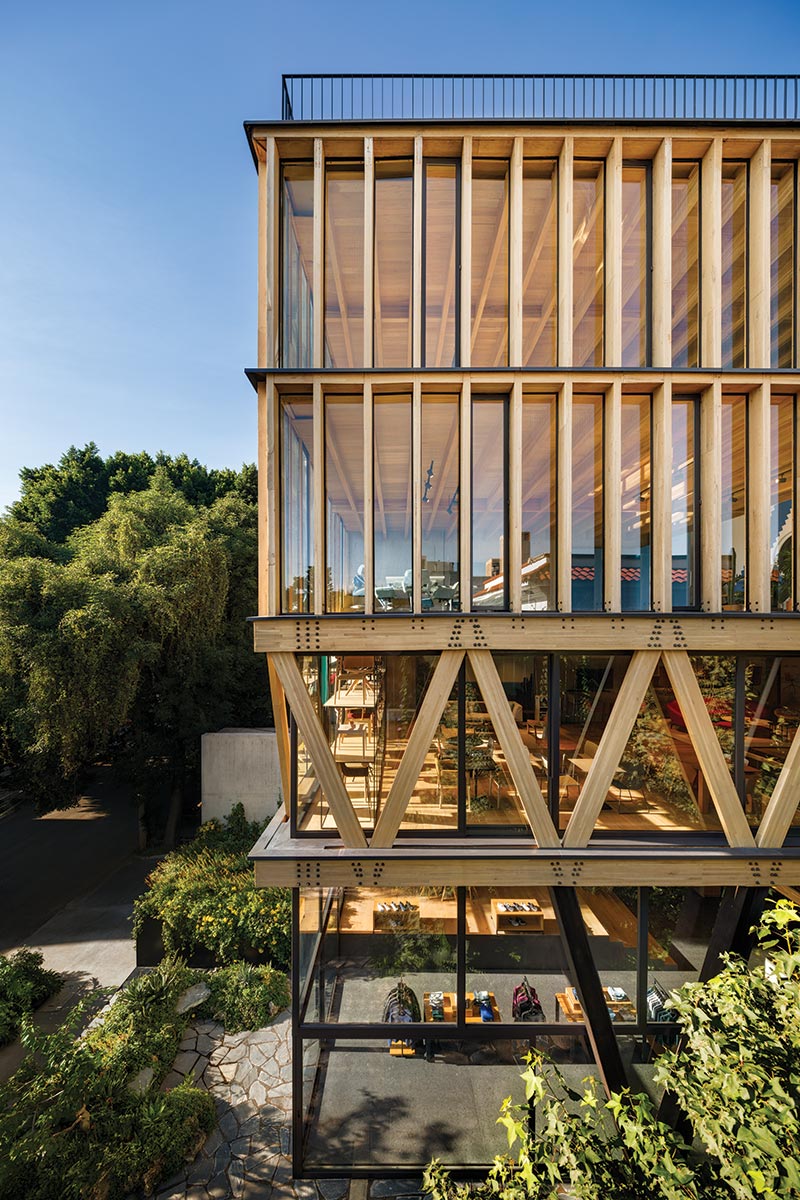
Photo courtesy of RAFAEL GAMO
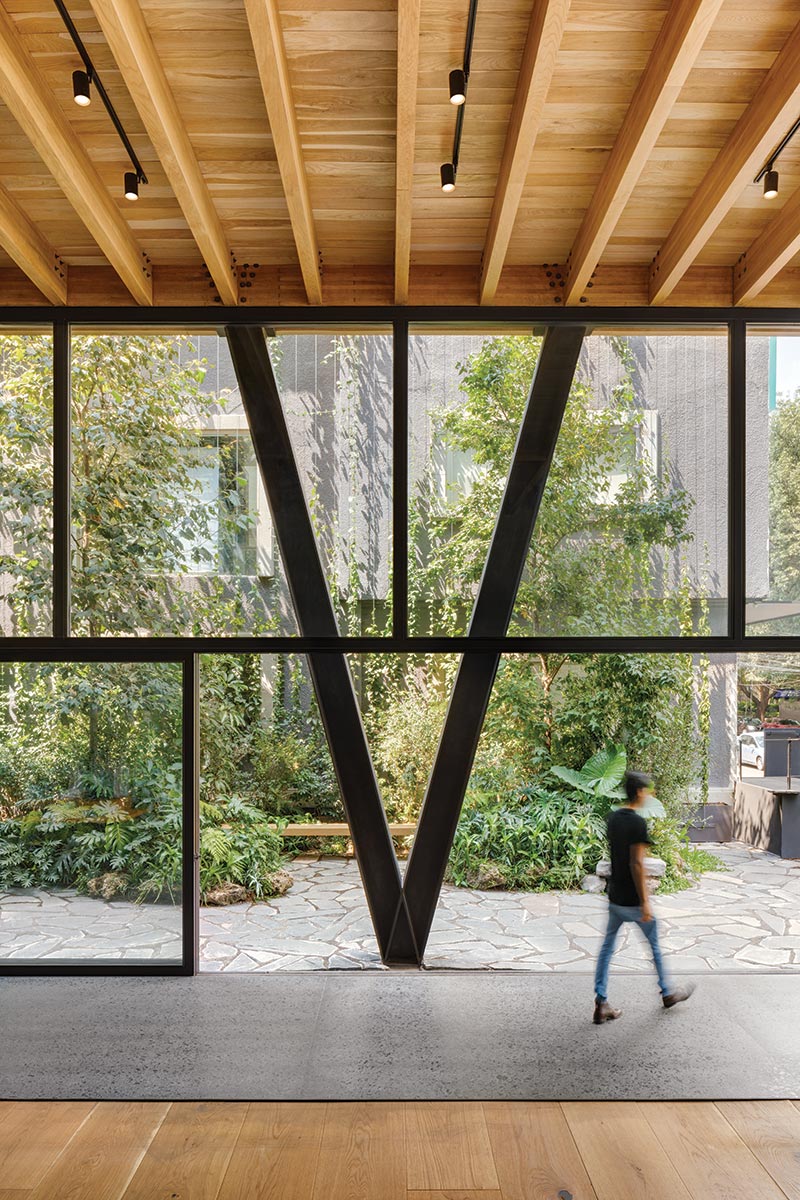
Photo courtesy of RAFAEL GAMO
FLORA
Gently curving elevations, punctuated by full-height windows and slatted-wood screens, will wrap Flora, a sculptural building in the Paris suburb of Nanterre. Designed by Vancouver-based mass-timber specialist Michael Green Architecture (MGA), with the French firm CALQ Agence d’Architecture as the architect of record, this nine-story, 90,000-square-foot residential-and-commercial project is slated for completion in 2024, as part of a broader plan to develop the emerging Les Groues district, not far from the business center La Défense. Triangular in plan, with a central courtyard, the massing consists of a two-story podium with two interconnected towers above it. The top seven floors will be residential, with a mix of market-rate and social-housing units, while the lower two stories will be a mix of retail, office, and coworking spaces. The round-cornered facades, dotted with balconies, will meet the street in a modern twist on the classic 19th-century facades of Paris, a city whose urban plan creates many triangular sites. With a primary structure of CLT and glulam above level three, “it’s really a showcase of what’s possible in wood,” says MGA founder Michael Green. Commissioned by developer Woodeum, Flora has already won the 2022 Bâtiment Bas Carbone Award for implementation of low-carbon practices. Ilana Herzig
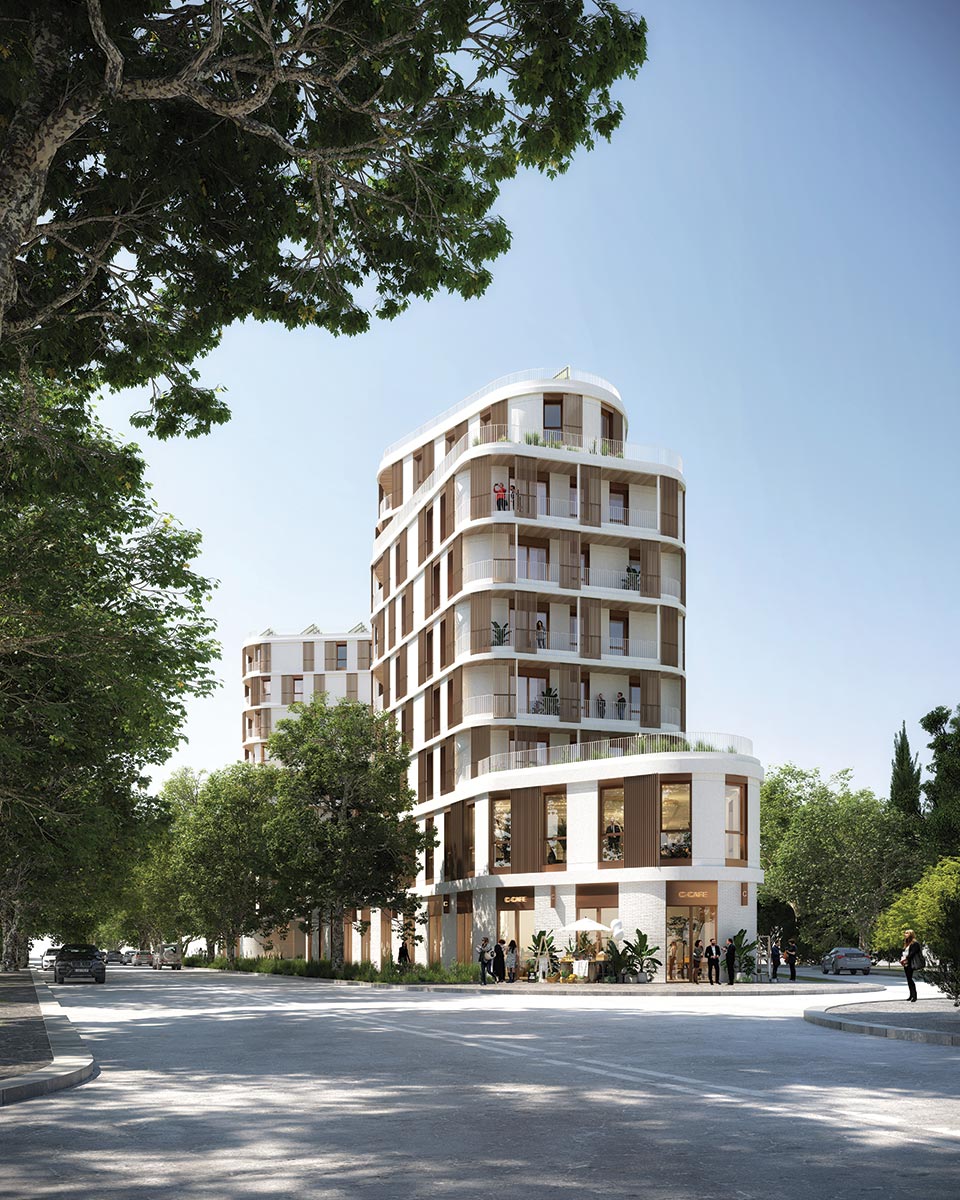
Image courtesy of MICHAEL GREEN ARCHITECTURE
ESBJERG MARITIME CENTER
This drumlike Maritime Center, designed by Snøhetta and WERK Arkitekter, in the Danish seaport town of Esbjerg, revolves around the notion of community. Forging a connection between Denmark’s west coast and the North Sea, the 40,900-square-foot laminated-pine structure sits on a waterfront site along boat slips, and hosts training and educational workshops as well as water sports. Powered by rooftop solar panels, the new facility, with its ring-shaped double courtyard, forms an amphitheater partly open to the elements, and accessible by land or sea—via boat launch, dock bridge, and footpaths. The building is clad and roofed in thermally modified pine from northern Denmark, echoing the craft of Nordic wood boat-making. Its elliptical plan encircles a raised terrace punctured by two oblong apertures that filter light into lower-level boat storage. Constructed to withstand extreme climatic events, the poured-in-place concrete first floor can accommodate high water. The vertical fins between the staggered windows evoke the rhythm of waves. With rectangular openings of varying sizes and proportions, the building glows like a lantern by night. IH
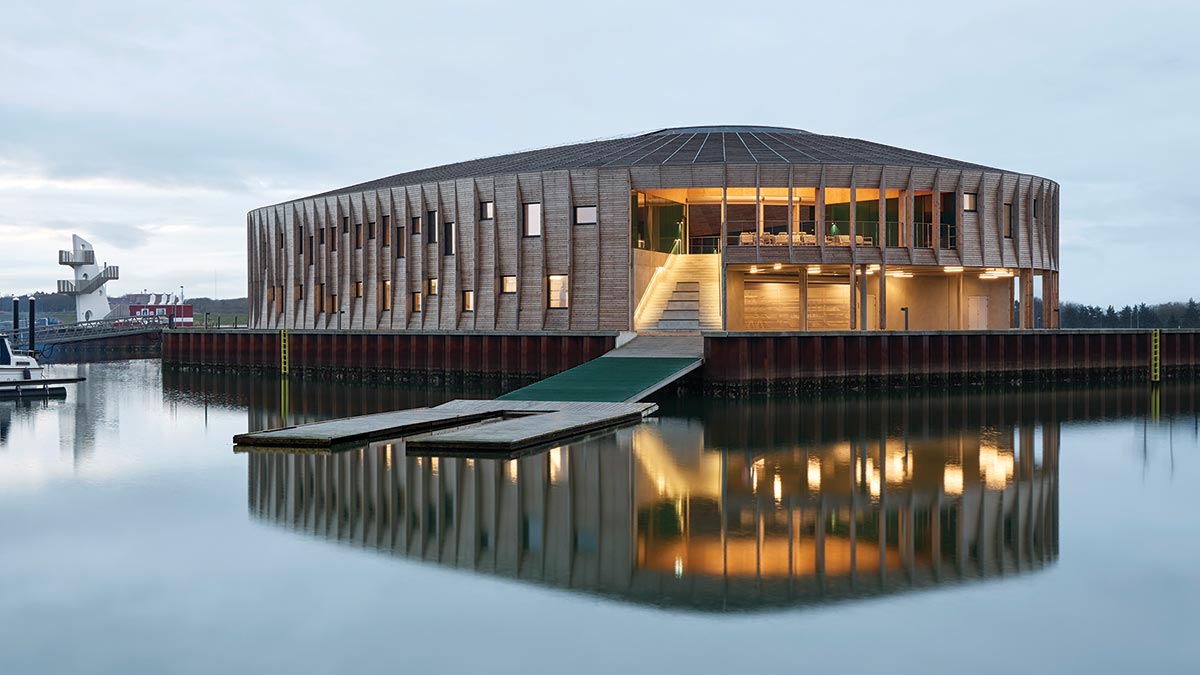
Photo © WICHMANN+BENDTSEN PHOTOGRAPHY
SCHOOL AND HOUSING
At Issy-les-Moulineaux, just outside Paris, the anticipation of Metro Line 15 (due to open late 2025) has prompted redevelopment of the surrounding neighborhood. Among the new buildings is a 2021 mixed-use complex by architects Brenac & Gonzalez, comprising a school and 104 social-sector apartments. Commissioned in 2017 by housing company Seine Ouest Habitat et Patrimoine (SOHP), the project features two distinct parts—a four-story concrete base containing two underground parking levels and two above-grade school floors and, rising from this podium, two eight-story residential blocks, offering a range of typologies from studios to four-bedroom apartments. Around concrete stair-and-elevator cores that ensure wind bracing, timber specialist Mathis built the dwellings from prefabricated CLT panels held together with metal connectors. Clad in a mix of pre-grayed larch and stainless steel, the apartments all feature balconies, realized as hybrid steel-wood structures bolted onto the facades. Timber offered advantages to both client and architect: for SOHP, it helped meet environmental targets; for Brenac & Gonzalez, wood’s relative lightness allowed construction of the housing on a different structural grid from the school, while the swift assembly of factory-fabricated components ensured they met the strict completion deadline. Andrew Ayers
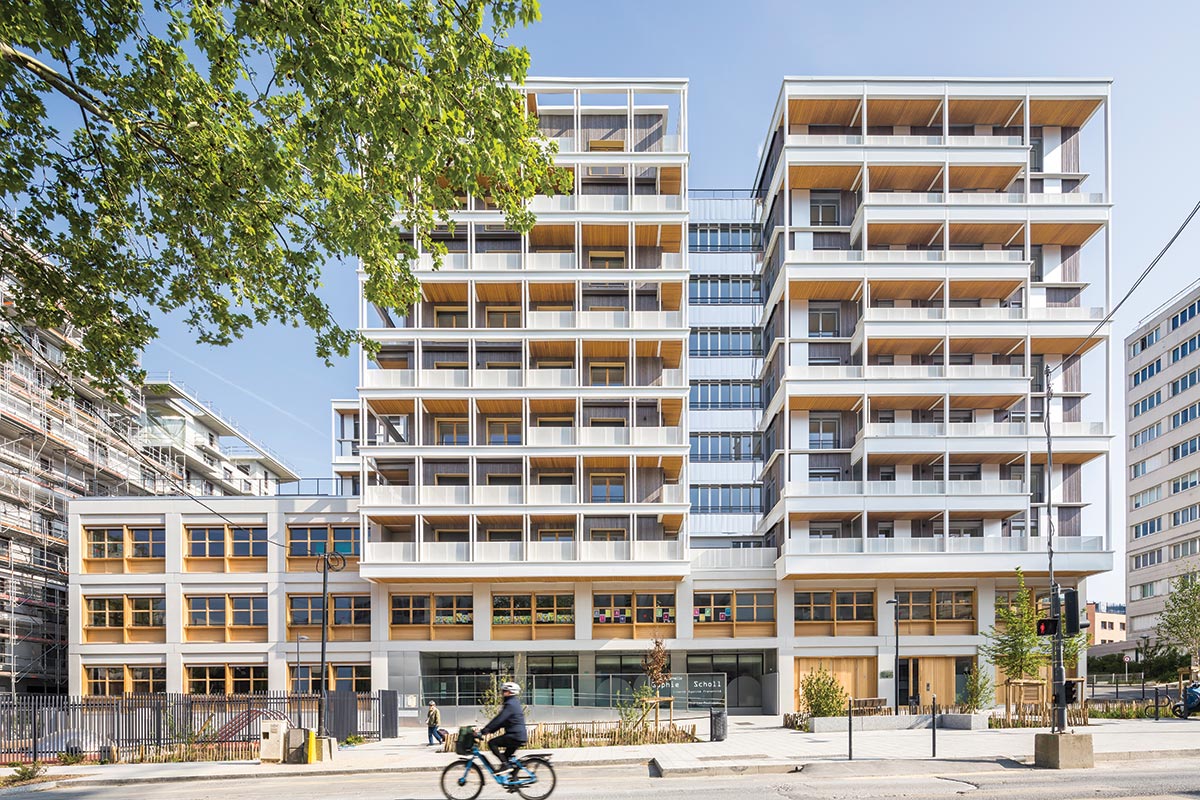
Photos © Sergio Grazia
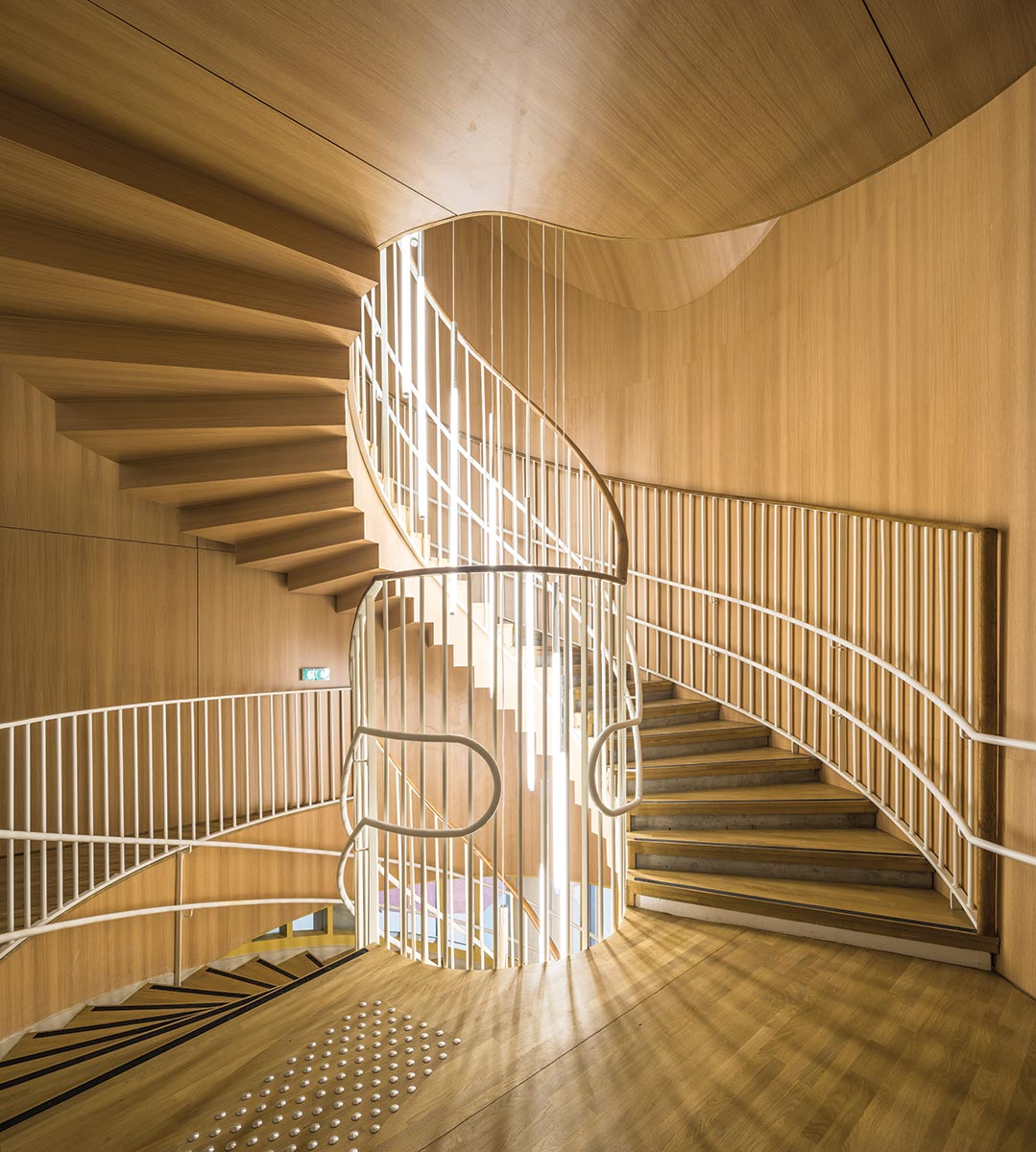
Photos © Sergio Grazia
KLOBOUCKÁ LESNÍ HQ
Nestled in the Czech town of Brumov-Bylnice, the headquarters for wood-products manufac-turer Kloboucká Lesní is an elongated structure with a steeply pitched roof and gabled ends, each shaped like an upward-pointing arrow. Mjölk Architekti, based in the Czech city of Liberec, designed it with a modular timber shell constructed from laminated-spruce “bioboards.” The company, which aims to advance sustainable forestry through “ancestral knowledge and techno-logical inquiry,” settled into the 10,800-square-foot building in 2022. Set against a moun-tainous backdrop, this multifunctional space—a stone’s throw from their manufac-turing center—includes areas for events and relaxation. Sourced predominantly from local timber grown in the surrounding forests and engineered on-site, the structure has a load-bearing glulam skeleton braced by steel, and a concrete core. With much of the roof covered by photovoltaic panels and a central boiler fueled by wood chips produced at the compound, the building generates enough energy to meet its own requirements. IH
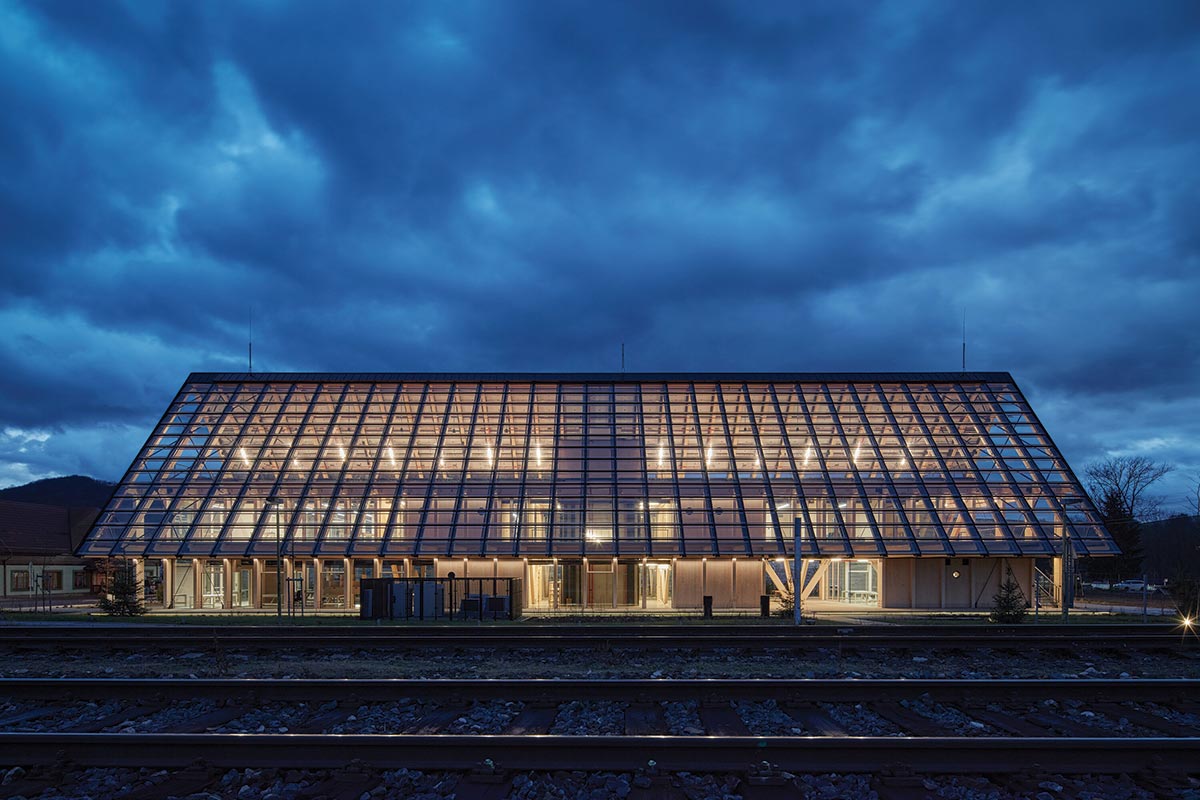
Photo © BOYSPLAYNICE
GLOBEVILLE LIBRARY AND APARTMENTS
Of Denver’s 78 neighborhoods, the name Globeville is among the most fitting. A multicultural, working-class enclave in the city’s northern reaches, it has been home to generations of immigrants—first from Central and Eastern Europe and later Latin America—who found employ in the neighborhood’s namesake smelter. Globeville is also known for its disconnections. Bounded on the east and south by the South Platte River and cleaved by railway lines, the former company town found itself fractured and even more isolated following the mid-20th-century construction of two major interstates that bisect its heart, displacing communities and leaving the cloistered and polluted neighborhood beset with neglect.
Efforts now under way to mend and revitalize Globeville include new affordable housing and overdue community resources. Combining both is a forthcoming project by Chicago-based John Ronan Architects (JRA) for the Globeville Development Partners, which will create a new branch of the Denver Public Library, topped by 173 units of family-oriented mixed-income housing, in response to encroaching gentrification. The design intentionally reflects the neighborhood’s gritty character through its cladding of two U-shaped hybrid mass-timber volumes, one in galvanized steel and the other in corrugated weathering steel, encircling a landscaped courtyard for residents and, in areas, library patrons.
Originally envisioned as a “stack of wood blocks,” the building has a poured-in-place concrete podium beneath five residential floors constructed with cross-laminated timber. Engineered wood also extends to nonstructural elements, including plywood in the library interior—shelving and ceiling and wall cladding—in another nod to Globeville’s blue-collar roots.
“There’s a theme of dirty/clean in the project, with Globeville being home to these historically dirty industries that need to be cleaned up,” says Ronan, “so CLT was fed into that narrative, in that it’s a very clean, sustainable technology—a new direction for Globeville.” Matt Hickman
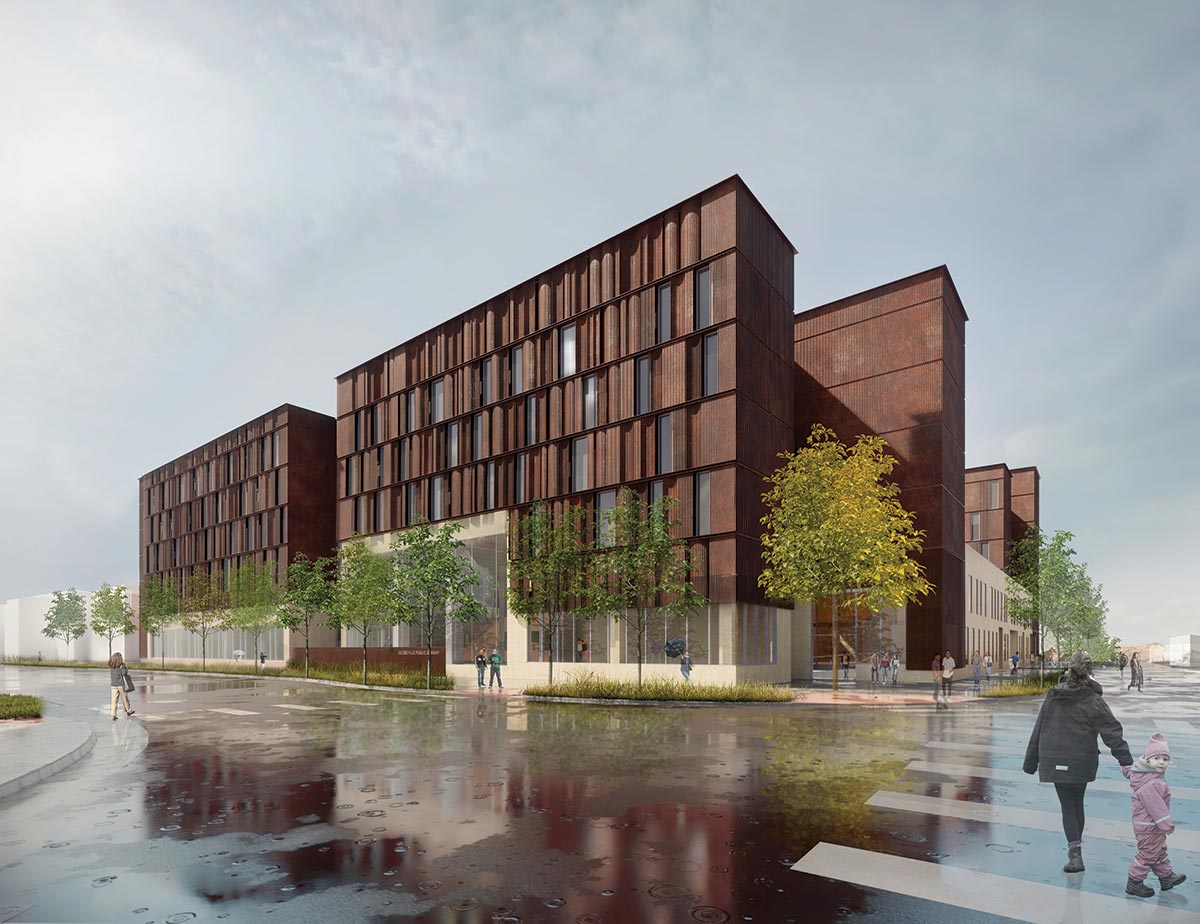
Image © John Ronan Architects
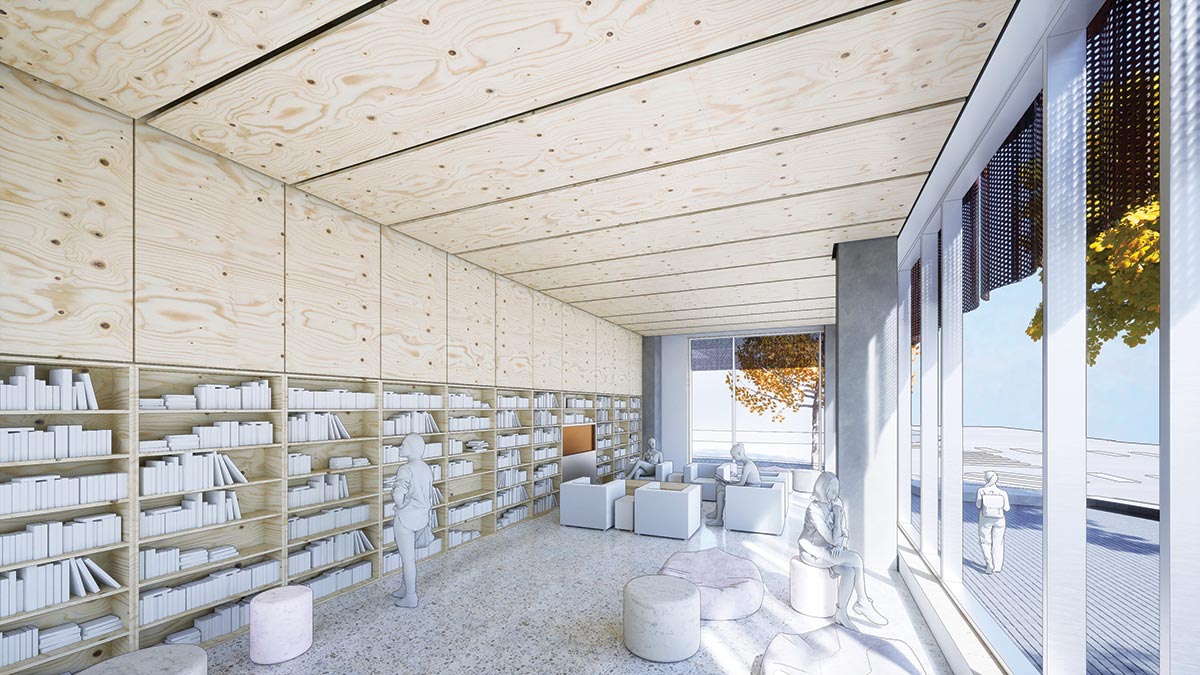
Image © John Ronan Architects
UNL COLLEGE OF ARCHITECTURE
Omaha-based HDR has garnered attention for its typology-spanning mass-timber projects, yet all these buildings, completed and in progress, are located outside the Cornhusker State (with most coming from the firm’s busy British Columbia offices). HDR is now, however, using engineered wood in its own backyard for a major addition at the University of Nebraska-Lincoln’s College of Architecture (plus one other mass-timber project elsewhere in the state). They’re joined by Boston-based NADAAA, which has won praise for its timber-and-steel-framed North Hall at the Rhode Island School of Design (RECORD, March 2020)—“not extensive experience, but substantial enough that it was something that we could bring to the table,” says NADAAA founder Nader Tehrani. Now under construction as the second phase of a larger overhaul of the College of Architecture, HDR and NADAAA’s four-story linear expansion built from glulam and CLT replaces the 1950s-era “stacks” addition at Architecture Hall West, yielding 14 new studios, a student lounge, and more. “It’s an interesting time line of buildings,” says HDR design director Tom Tren-olone, of the college’s eclectic assemblage of structures—which includes two main halls, completed in 1892 and 1912, a connective atrium known as the Link that debuted in 1987, and soon this mass-timber addition. “It’s very appropriate for a college of architecture.” MH

Images courtesy HDR + Nadaaa
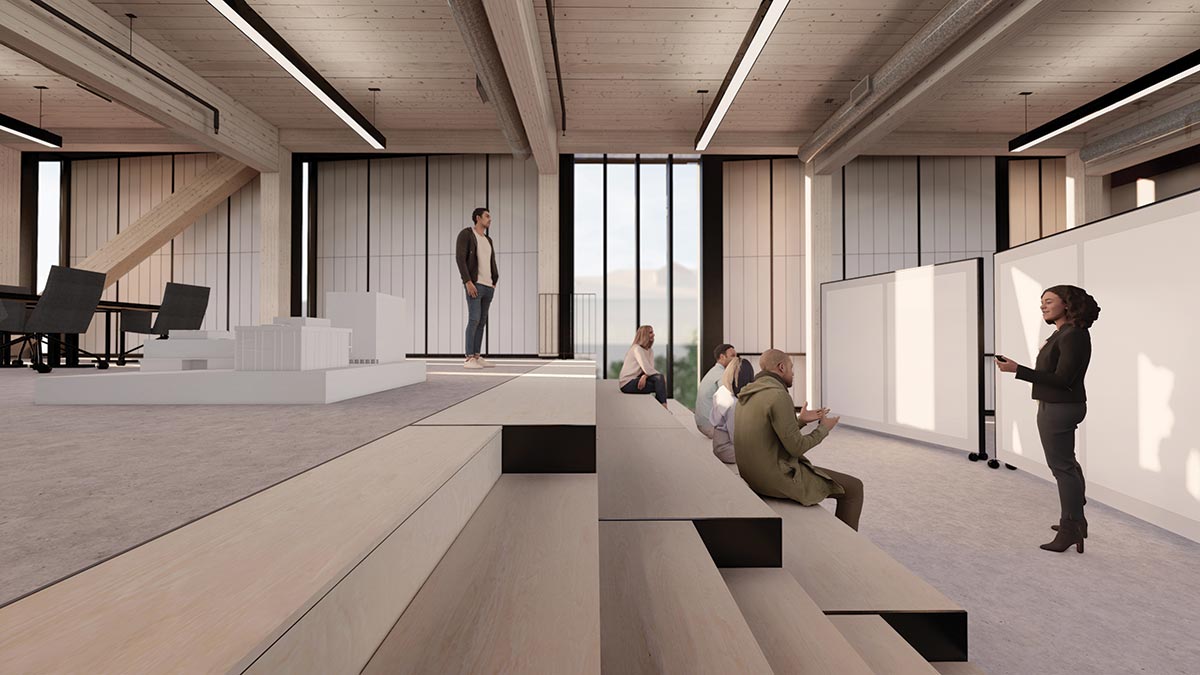
Images courtesy HDR + Nadaaa
TIMBERLANDS CENTER
Site work has commenced on the Anthony Timberlands Center for Design and Materials Innovation at the University of Arkansas. This is the first project in the U.S., and the first built with timber, for Pritzker Prize–winning firm Grafton Architects, which is working with local firm modus studio. As part of the Fay Jones School of Architecture and Design, it will be a space for fabrication, research, and development, constructed significantly of timber and wood sourced in Arkansas, the eighth-largest timber producer in the U.S. It will be home to the school’s ongoing design-build and graduate programs and collaborative efforts with partners in the state’s forest industries. It is expected to complete at the end of 2024. Josephine Minutillo
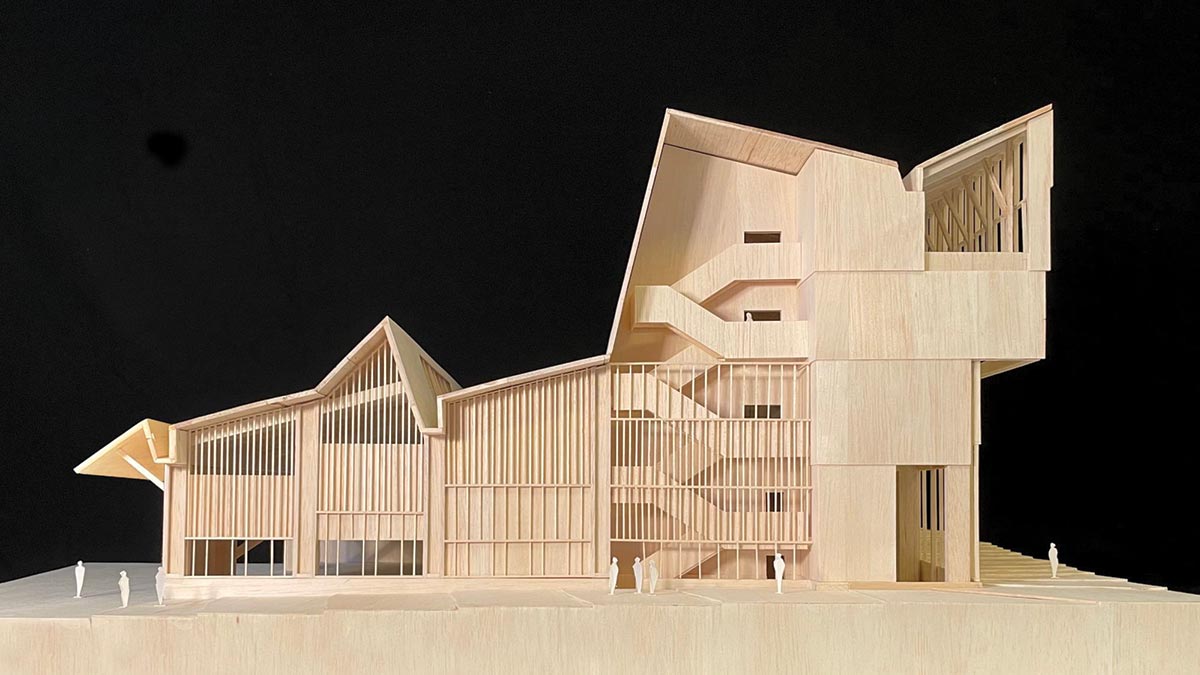
Photo courtesy Grafton Architects and Modus Studio
OFFICE BUILDING
“The right material in the right place,” says architect Anne Carcelen of this eight-story office building in Paris’s 19th arrondissement. One element in the redevelopment of a former industrial area, and completed in 2021, the project is located on an awkward wedge-shaped site next to railroad tracks. The partly state-owned developer, Icade, wanted to set an example by building in mass timber, and commissioned Carcelen for her experience with the technique, which includes the 2014 Lycée Nelson Mandela in Nantes, designed when she was a partner at Leclercq Associés. With a concrete elevator core and concrete base, the cross-laminated-spruce frame, which is left largely exposed inside, carries prefabricated concrete-slab floors, chosen for their acoustic properties and speed of assembly.
A similar pragmatism prevails in the treatment of the timber-framed facades, using folded red-brown zinc cladding on the two longest eleva-tions—both diffusing train noise and evoking the site’s industrial past—and, at either end, glass curtain walls. BIM, employed for design, construc-tion, and maintenance, was essential in realizing the many one-off pieces required for the building’s irregular shape. A proponent of environmentally responsible construction, Carcelen is now bringing her expertise to the U.S. as a partner in the New York firm OulipO. AA

Photo © Nicolas Grosmond









